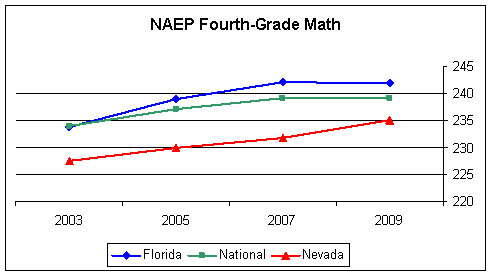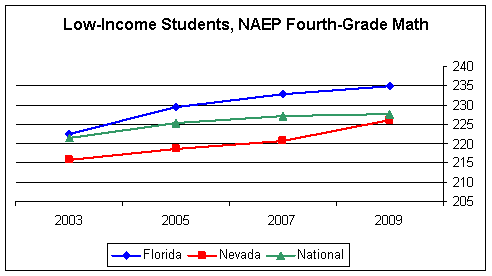Math scores mixed
The importance of math proficiency shows up in the market's demand for it. Well-paying careers — those of accountants, computer programmers, economists, engineers, scientists and many others — all require it.
So how well does Nevada's public education system teach math? The answer is mixed, with both good news and bad.
The bad news is that, at the fourth-grade level, Nevada's student achievement continues to fall below the national average on the National Assessment of Educational Progress (NAEP) math exam. White, black, Asian and low-income students perform below their counterparts across the nation, while Nevada's Hispanic students are only even with theirs.
Table 1: NAEP Fourth-Grade Math Exam Scores, 2009
|
Nevada |
Florida |
Nation |
|
|
All Students |
235 |
242 |
239 |
|
White |
245 |
250 |
248 |
|
Black |
218 |
228 |
222 |
|
Hispanic |
227 |
238 |
227 |
|
Asian |
245 |
261 |
255 |
|
Low-income |
226 |
235 |
228 |
None of this mediocrity is necessary. Note that Florida, as shown in the chart above, continues to out-perform the national average after a decade of reform. An NPRI report titled "Failure Is No Longer an Option" noted that even Florida's low-income Hispanic students outperformed the average of all Nevada students on the NAEP fourth-grade reading exam. In fourth-grade mathematics, they dominate Nevada and the nation across all categories.
The good news for Nevada is that since the last NAEP test in 2007, Silver State students have increased achievement on the fourth-grade math exam more than did a national average of students.
Graph 1: NAEP Fourth-Grade Math Scores 2003-2009

Nevada's low-income students continue to score below average, but they also saw a rapid increase in achievement.
Graph 2: NAEP Fourth-Grade Math Scores for Low-Income Students, 2003-2009

The difference in the improvement of Nevada students compared to their national counterparts was 1.16 percent — 3.36 percent for Nevada, compared to 2.2 percent nationwide. The improvement in Nevada's student achievement was centered on white, Hispanic and low-income students.
The latest NAEP scores also show that the achievement gap between Nevada's middle- and high-income students and low-income students has decreased. Scores for low-income students — those eligible for the Federal Free and Reduced Lunch Program — increased 4.82 percent, above the national average. Students ineligible for the free lunch program saw a 2.11 percent achievement gain.
Nevada's black and Asian students, however, saw lower growth than their counterparts across America. While the achievement gap between whites and Hispanics has diminished since 2003, the achievement gap between whites and blacks has increased. Between 2003 and 2009, white students in Nevada saw achievement gains on the fourth-grade math exam that were more than double the gains for black students in Nevada. Between whites and Asians in Nevada, no achievement gap currently exists.
Table 2: Percentage growth in achievement on the NAEP Fourth-Grade Math Exam, 2003-2009
|
Nevada |
Florida |
Nation |
|
|
All Students |
3.36% |
3.52% |
2.20% |
|
White |
3.87% |
3.08% |
2.11% |
|
Black |
1.58% |
6.28% |
2.85% |
|
Hispanic |
5.07% |
2.63% |
2.62% |
|
Asian |
3.33% |
4.52% |
3.66% |
|
Low-income |
4.82% |
5.53% |
2.70% |
What this most recent national report card on education reveals is that, while recent gains in student achievement are somewhat promising, the achievement gaps in Nevada are still very large.
In this context, what Florida has demonstrated is crucially important: that all the public-education establishment's shibboleths — student demographics, poverty, learning disabilities, teacher pay and per-pupil spending — are nothing more than poor excuses.
Florida has proven that student achievement in public education improves when proper incentives operate. Vouchers, tax credits, charter schools, virtual schools, merit pay, meaningful teacher evaluations, alternative teacher certifications and bans on social promotion all played a role in Florida's dramatic gains.
Nevada policymakers need to stop playing politics, stop evading the empirical evidence and institute meaningful education reform.
Silver State kids and their parents deserve no less.
Patrick R. Gibbons is an education policy analyst at the Nevada Policy Research Institute.